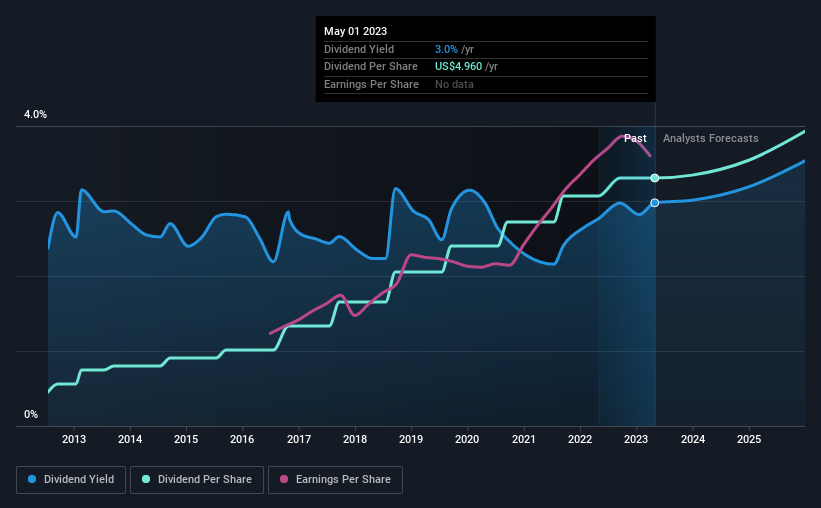Just Two Days Till Texas Instruments Incorporated (NASDAQ:TXN) Will Be Trading Ex-Dividend
Readers hoping to buy Texas Instruments Incorporated (NASDAQ:TXN) for its dividend will need to make their move shortly, as the stock is about to trade ex-dividend. The ex-dividend date is one business day before the record date, which is the cut-off date for shareholders to be present on the company's books to be eligible for a dividend payment. The ex-dividend date is an important date to be aware of as any purchase of the stock made on or after this date might mean a late settlement that doesn't show on the record date. Thus, you can purchase Texas Instruments' shares before the 5th of May in order to receive the dividend, which the company will pay on the 16th of May.
The company's next dividend payment will be US$1.24 per share, and in the last 12 months, the company paid a total of US$4.96 per share. Based on the last year's worth of payments, Texas Instruments has a trailing yield of 3.0% on the current stock price of $166.68. If you buy this business for its dividend, you should have an idea of whether Texas Instruments's dividend is reliable and sustainable. That's why we should always check whether the dividend payments appear sustainable, and if the company is growing.
Check out our latest analysis for Texas Instruments
Dividends are typically paid out of company income, so if a company pays out more than it earned, its dividend is usually at a higher risk of being cut. Texas Instruments paid out more than half (53%) of its earnings last year, which is a regular payout ratio for most companies. Yet cash flow is typically more important than profit for assessing dividend sustainability, so we should always check if the company generated enough cash to afford its dividend. It paid out 99% of its free cash flow in the form of dividends last year, which is outside the comfort zone for most businesses. Cash flows are usually much more volatile than earnings, so this could be a temporary effect - but we'd generally want to look more closely here.
Texas Instruments paid out less in dividends than it reported in profits, but unfortunately it didn't generate enough cash to cover the dividend. Cash is king, as they say, and were Texas Instruments to repeatedly pay dividends that aren't well covered by cashflow, we would consider this a warning sign.
Click here to see the company's payout ratio, plus analyst estimates of its future dividends.
Have Earnings And Dividends Been Growing?
Businesses with strong growth prospects usually make the best dividend payers, because it's easier to grow dividends when earnings per share are improving. If business enters a downturn and the dividend is cut, the company could see its value fall precipitously. Fortunately for readers, Texas Instruments's earnings per share have been growing at 20% a year for the past five years. Earnings have been growing at a decent rate, but we're concerned dividend payments consumed most of the company's cash flow over the past year.
Another key way to measure a company's dividend prospects is by measuring its historical rate of dividend growth. Texas Instruments has delivered 22% dividend growth per year on average over the past 10 years. Both per-share earnings and dividends have both been growing rapidly in recent times, which is great to see.
The Bottom Line
Should investors buy Texas Instruments for the upcoming dividend? The best dividend stocks typically boast a long history of growing earnings per share (EPS) via a combination of earnings growth and buybacks. That's why we're glad to see Texas Instruments growing its EPS, buying back stock and paying out a reasonable percentage of its earnings as dividends. However, we note with some concern that it paid out 99% of its free cash flow last year, which is uncomfortably high and makes us wonder why the company chose to spend even more cash on buybacks. Overall, it's not a bad combination, but we feel that there are likely more attractive dividend prospects out there.
So if you want to do more digging on Texas Instruments, you'll find it worthwhile knowing the risks that this stock faces. For example, we've found 3 warning signs for Texas Instruments (1 can't be ignored!) that deserve your attention before investing in the shares.
A common investing mistake is buying the first interesting stock you see. Here you can find a full list of high-yield dividend stocks.
Have feedback on this article? Concerned about the content? Get in touch with us directly. Alternatively, email editorial-team (at) simplywallst.com.
This article by Simply Wall St is general in nature. We provide commentary based on historical data and analyst forecasts only using an unbiased methodology and our articles are not intended to be financial advice. It does not constitute a recommendation to buy or sell any stock, and does not take account of your objectives, or your financial situation. We aim to bring you long-term focused analysis driven by fundamental data. Note that our analysis may not factor in the latest price-sensitive company announcements or qualitative material. Simply Wall St has no position in any stocks mentioned.
Join A Paid User Research Session
You’ll receive a US$30 Amazon Gift card for 1 hour of your time while helping us build better investing tools for the individual investors like yourself. Sign up here

 Yahoo Finance
Yahoo Finance 
